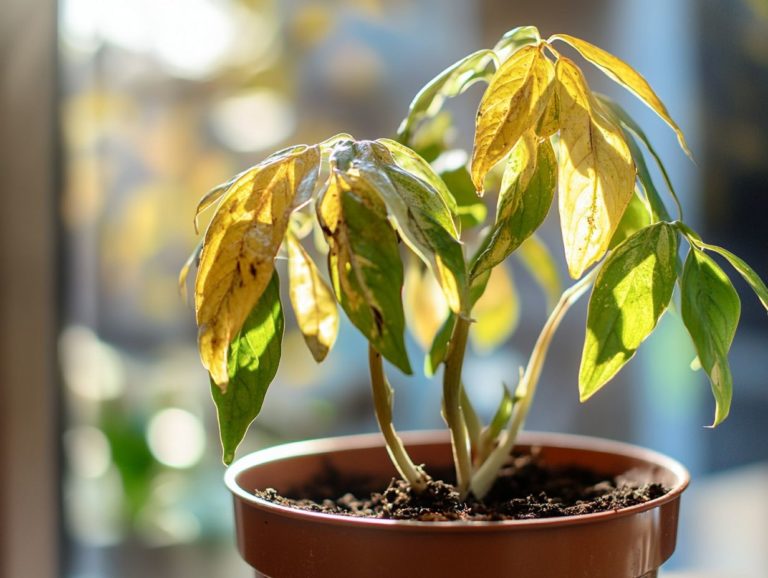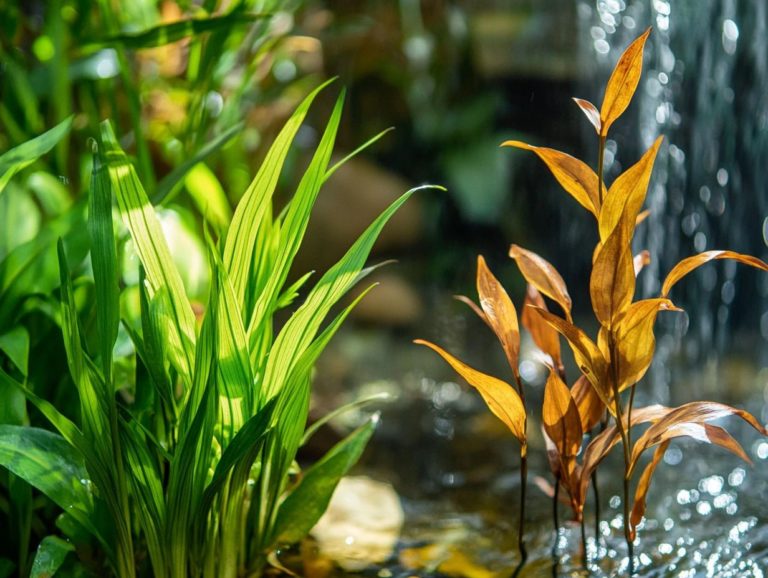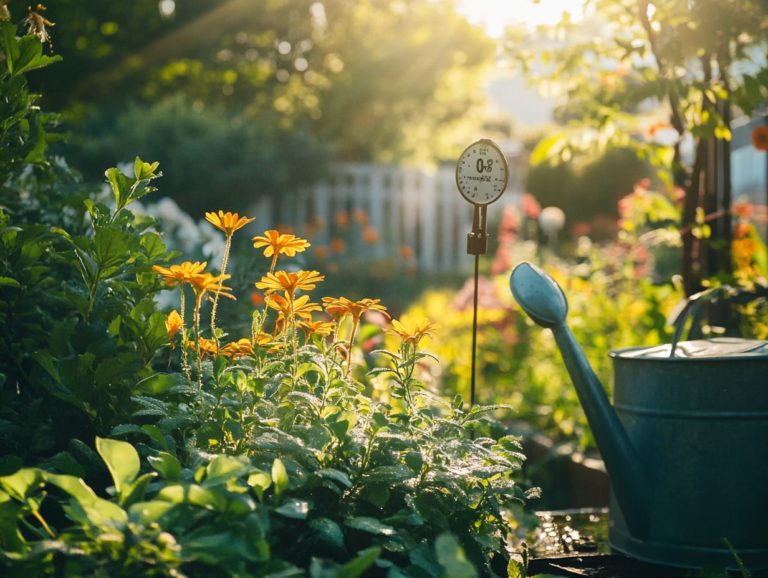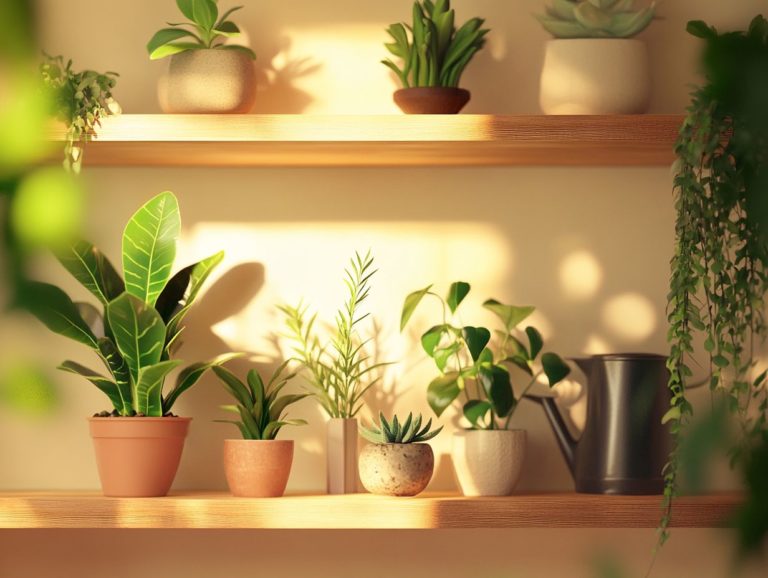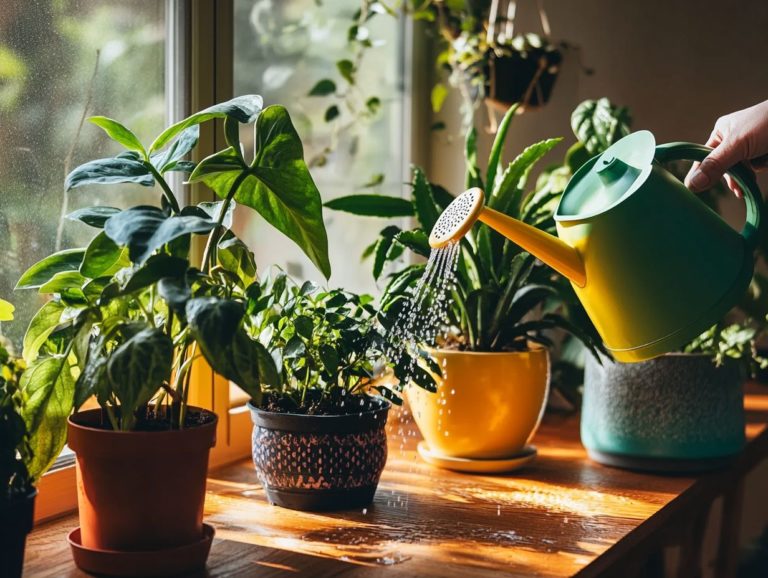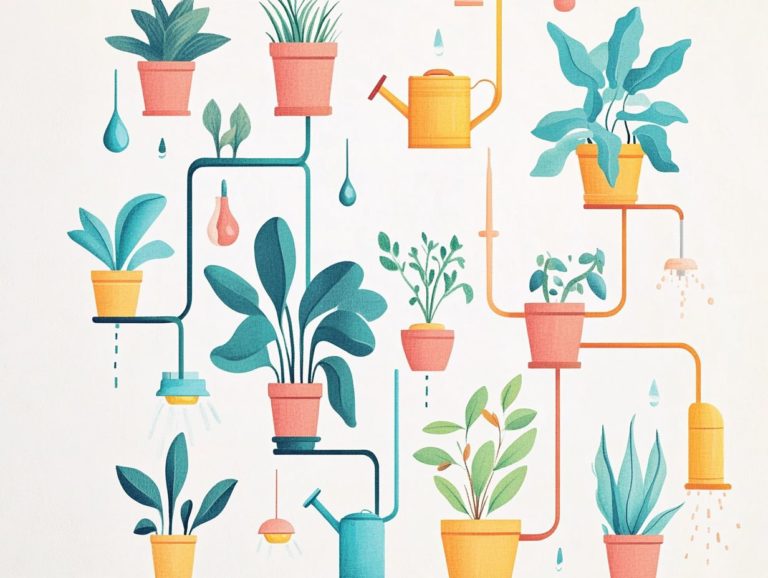5 Unique Watering Techniques for Exotic Plants
Exotic plants add a touch of the extraordinary to your gardens and homes, but they often require special care particularly when it comes to watering. Standard methods may not suffice for these unique flora, which thrive in specific conditions.
This article delves into five innovative watering techniques perfectly tailored for exotic plants: bottom watering, drip irrigation, self-watering pots, wicking systems, and capillary mats. Each method presents distinct benefits, ensuring your vibrant plants receive the hydration they truly need.
Explore these techniques to find the ideal solution for nurturing your botanical treasures!
Contents
- Key Takeaways:
- 1. Bottom Watering
- 2. Drip Irrigation
- 3. Self-Watering Pots
- 4. Wicking System
- 5. Capillary Mats
- What Are Exotic Plants and Why Do They Need Special Watering Techniques?
- What Are the Benefits of Bottom Watering?
- How Does Drip Irrigation Work and Why Is It Suitable for Exotic Plants?
- What Are Self-Watering Pots and How Do They Help with Watering Exotic Plants?
- How Does the Wicking System Work and What Are Its Advantages?
- What Are Capillary Mats and How Can They Help with Watering Exotic Plants?
- What Are the Common Mistakes to Avoid When Watering Exotic Plants?
- How Can One Determine the Right Watering Technique for Their Exotic Plants?
- What Are Some Tips for Maintaining Proper Watering for Exotic Plants?
- What Are Some Other Factors to Consider When Watering Exotic Plants?
- Frequently Asked Questions
- What are the benefits of using 5 unique watering techniques for exotic plants?
- What is the first technique to consider when watering exotic plants?
- How can I ensure my exotic plants are receiving enough water?
- Why is bottom watering a good technique for exotic plants?
- When is the best time of day to water exotic plants?
- Are there any precautions to take when watering exotic plants?
Key Takeaways:
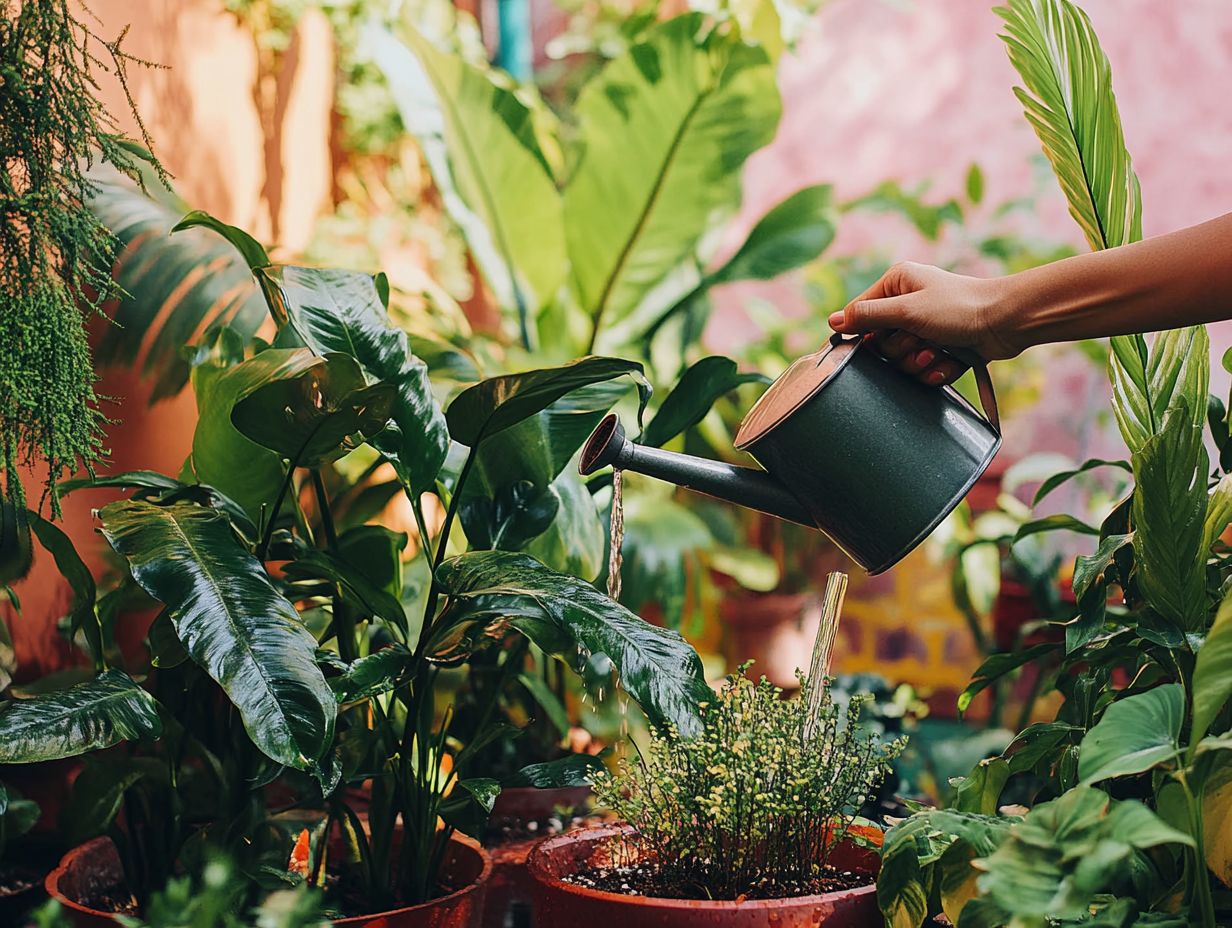
- Bottom watering helps exotic plants by allowing for deep root growth and preventing water from getting on foliage, reducing the risk of root rot and fungal diseases.
- Drip irrigation is a great choice for exotic plants as it provides a consistent and controlled water supply, preventing over or under-watering.
- Self-watering pots are a convenient option for exotic plants, using a reservoir system to supply water to the plant’s roots as needed.
1. Bottom Watering
Bottom watering is an effective method that enhances your plant care skills. It ensures optimal soil moisture levels for various species, especially tropical houseplants with unique watering needs.
This method effectively wards off the dreaded overwatering and root rot, promoting robust growth while minimizing water loss and evaporation.
By allowing water to enter through drainage holes, your plants can evenly absorb moisture from the bottom of the pot, creating a stable environment tailored to their unique requirements. Adopting this approach not only enhances plant health but also supports efficient water conservation and management.
To implement bottom watering, simply fill a tray or basin with water and place your pots in it, letting the soil soak up moisture from beneath. The benefits of this method include fostering deeper root growth and reducing soil compaction.
Aroids, ferns, and succulents thrive on consistent moisture without the risk of becoming waterlogged. For the best results, select pots with drainage holes that are at least 6 to 8 inches in diameter, ensuring excess water can escape while retaining enough for your plants to flourish.
Regularly monitor soil moisture levels to prevent excessive saturation, and adjust your watering frequency based on the environmental conditions.
2. Drip Irrigation
Drip irrigation is a precise watering technique that efficiently delivers water right to the roots of your plants, making it the perfect solution for outdoor shrubs and gardens in diverse environmental conditions.
This method minimizes water waste and evaporation while ensuring your plants receive the hydration they need, even when faced with seasonal changes or droughts.
By tapping into multiple water sources, drip irrigation fosters healthy growth and reduces the risk of overwatering, all while conserving precious water resources.
To set up an effective system, familiarize yourself with the main components: the mainline, emitters, filters, and pressure regulators. Tailor the installation to meet the specific needs of your plants; consider factors like soil type and plant spacing to create the best fit.
Regular maintenance is essential. Checking for clogs and ensuring emitters are functioning properly can significantly boost your system’s efficiency. This method is especially beneficial for a variety of plant types, from vegetables to ornamental flowers, as it adapts seamlessly to unique garden layouts, guaranteeing optimal water delivery no matter the size or shape of your garden.
3. Self-Watering Pots
Self-watering pots provide an elegant solution for maintaining consistent moisture levels. They support your watering routine for both indoor and outdoor plants. These smart pots supply water steadily. They help prevent wilting and root rot, keeping your plants healthy. With a built-in reservoir, these pots can accommodate various sizes and types, making them suitable for a diverse range of plant species, including flowering plants that grow back year after year.
The design features a bottom reservoir and a wicking system, allowing the soil to draw water as needed. This eliminates the guesswork that often comes with traditional watering methods. When selecting a self-watering pot, it’s essential to choose the right size based on your plant’s root system. Larger plants may need pots with more substantial reservoirs.
To ensure optimal performance, fill the reservoir with clean water and avoid any contaminants. Regularly check the water level and maintain soil health to enhance your plants’ thriving capability. This makes gardening easier and more enjoyable for enthusiasts of all skill levels, especially with drought-resistant varieties.
4. Wicking System
A wicking system is a great way to water your plants. It uses water movement to draw moisture from a reservoir into the soil, making it particularly advantageous for flowering plants and various other types. This method guarantees deep watering that reaches the root zone. Your plants can absorb just the right amount of moisture without the risk of over-saturation. You might consider using a moisture meter to monitor soil moisture levels. This will help you maintain optimal conditions for your plants’ health.
To establish a successful wicking system, select suitable wicking materials, such as cotton ropes or specialized wicking pads. These materials efficiently facilitate moisture movement. The reservoir should be designed to hold enough water to support your chosen plants, whether they re indoors or outdoors. Popular choices for this technique include:
- leafy greens
- tomatoes
- peppers
Positioning your system in a spot with ample light is essential. Don t forget to check and refill the reservoir regularly to ensure your plants enjoy prolonged health and vitality.
5. Capillary Mats

Capillary mats help maintain moisture in indoor gardens and greenhouses. They draw water up to the roots, ensuring even distribution and preventing evaporation. By distributing moisture evenly, these mats enhance water conservation and create an ideal environment for a variety of plant species.
If you’re looking to simplify your watering routine while ensuring your plants receive the hydration they need, these mats are a perfect choice for indoor gardens and outdoor setups alike.
You ll find capillary mats in various types, from lightweight options to more robust, heavy-duty versions. This allows you to select the one that meets your specific gardening needs. Integrating these mats into your gardening setup whether using pots, trays, or raised beds can significantly boost their effectiveness.
To maintain optimal moisture levels, consider the unique needs of your plants. For instance, moisture-loving varieties may flourish with a thicker mat. Regularly monitoring and making occasional adjustments will help you refine your watering strategy, fostering vibrant growth across a diverse array of flora.
What Are Exotic Plants and Why Do They Need Special Watering Techniques?
Exotic plants, like tropical houseplants, have unique watering needs. They require your careful attention. These plants are particularly sensitive to their environment and the type of soil they inhabit. Unlike native species, they often struggle in typical garden setups where standard watering techniques simply don t cut it. This can lead to frustrating outcomes like wilting leaves and pesky root rot.
To ensure your exotic plants thrive, it’s essential to grasp their specific watering needs. Improper care can stunt their growth and affect their overall health. Thus, utilizing the best watering techniques for indoor plants tailored to their unique characteristics is vital for nurturing these stunning and diverse plant species.
For instance, many tropical plants prefer consistently moist soil yet are susceptible to overwatering. Finding that sweet spot is crucial. Regularly checking soil moisture levels is a smart move, along with being mindful of the plant’s growth stage and the shifts in seasons.
Utilizing methods like bottom watering or self-watering pots can foster healthy root development while minimizing the risks tied to excess moisture. By understanding common challenges such as humidity requirements and light exposure, you can elevate your care routine, creating an ideal environment that caters to the specific needs of these exotic beauties. Additionally, be sure to debunk 5 watering myths about indoor plants to enhance your gardening knowledge.
What Are the Benefits of Bottom Watering?
Bottom watering presents a wealth of advantages for your plant care regimen. It promotes consistent moisture levels while effectively minimizing the risk of root rot and other common watering woes. By allowing your plants to absorb water from the bottom, this method ensures even moisture distribution, which is particularly beneficial for sensitive species that flourish in specific humidity conditions.
You can also use bottom watering as a water-saving technique. It reduces evaporation and fosters sustainable gardening practices, leading to healthier plants and less water usage.
This method boosts root health and leads to vibrant growth. To implement bottom watering effectively, simply place your planters in a shallow tray filled with water, allowing them to soak it up gradually. It’s crucial to keep an eye on moisture levels, as over-saturation can lead to its own set of problems.
Plants like peace lilies, ferns, and African violets particularly thrive with this technique. It makes it a superb choice for both novice and seasoned gardeners alike. Ultimately, embracing bottom watering can revolutionize your plant care routine, resulting in a flourishing and vibrant indoor or outdoor garden. To enhance your plant care further, consider these 5 ways to promote healthy indoor plants, especially for tropical houseplants.
How Does Drip Irrigation Work and Why Is It Suitable for Exotic Plants?
Drip irrigation is a way to give your plants the perfect amount of water right at their roots. It uses tubes to deliver water slowly and evenly. This method is particularly ideal for exotic plants, which often thrive on specialized watering techniques. By ensuring that water is used efficiently, it allows your plants to receive the essential hydration they need without any waste especially important during drought conditions, which can affect native plants and vegetable gardens.
By adapting to the specific requirements of different plant species, drip irrigation encourages healthy growth while minimizing the risk of overwatering, which can be detrimental to those more delicate exotic varieties.
This innovative approach does more than just save water; it positively impacts the environment by reducing runoff and preventing soil erosion. Tailoring your drip systems to meet the unique moisture needs of various plants, from succulents and cacti to tropical species, creates a customized experience that enhances growth and vitality.
For optimal results, it s crucial to regularly check your system for leaks or clogs, adjust emitter flow rates as necessary, and thoughtfully plan the layout to cater to each plant’s individual needs. By implementing these best practices, you can reap the many benefits of drip irrigation while championing sustainability in your garden, particularly concerning water recycling and irrigation systems.
What Are Self-Watering Pots and How Do They Help with Watering Exotic Plants?
Self-watering pots can revolutionize how you care for your exotic plants! These sophisticated containers manage the intricate watering needs of your plants by maintaining consistent moisture levels while minimizing the frequency of watering routines. This is essential for preventing root rot.
These pots are designed with a reservoir that continually delivers water to the soil, catering specifically to tropical and subtropical species that require precise moisture control. When selecting the right pot size, consider your plant’s growth potential. A pot that s too small can stunt root development, while one that s excessively large may create stagnant water.
To maintain the water reservoir effectively, keep these best practices in mind, particularly concerning drainage holes, which are vital for managing excess water:
- Regularly check water levels
- Ensure roots aren t excessively submerged
- Occasionally flush the system to prevent algae buildup
By adhering to these guidelines, you can cultivate a thriving ecosystem that meets the unique needs of your exotic favorites, including herbaceous perennials and various flower types.
How Does the Wicking System Work and What Are Its Advantages?

The wicking system operates through capillary action, which is the ability of a liquid to flow in narrow spaces without external forces like gravity. This reliable watering technique draws moisture from a reservoir into the soil, supporting a diverse range of plant species, including herbaceous perennials. By ensuring deep watering, it fosters optimal moisture levels while significantly reducing the risk of overwatering and root rot.
With its self-regulating moisture capabilities, the wicking system cultivates an ideal environment for robust root development, making it an excellent choice for gardeners seeking efficient watering solutions.
To implement this innovative system, you’ll need materials such as a water reservoir, wicking materials like cotton rope or synthetic strips and an appropriate planting medium. Position the wicking materials strategically in the soil to allow water to rise as needed.
This setup proves beneficial for various types of plants, particularly drought-resistant species and native plants, as it maintains consistent moisture levels without requiring constant attention. Best practices involve regularly checking the reservoir and ensuring the wicks remain unclogged to facilitate an effective water supply to your garden.
By adhering to these guidelines, you can achieve flourishing plants while minimizing water usage.
What Are Capillary Mats and How Can They Help with Watering Exotic Plants?
Capillary mats offer a remarkable solution for watering, skillfully maintaining ideal moisture levels for your exotic plants while promoting responsible water conservation. These mats efficiently draw water from a reservoir and distribute it evenly across the surface, ensuring your plants receive consistent hydration without the risks of overwatering. By utilizing capillary action, they create an optimal growing environment for a diverse array of exotic plant species that require specialized attention.
Integrating capillary mats into your gardening setups can elevate both your indoor and outdoor spaces, making them perfect for pots, seed trays, and even larger garden beds. When choosing a mat, consider factors like the size of your garden area, the specific water requirements of your plants, and the type of reservoir you’ll use some may need more frequent refilling than others.
By strategically placing the mats and keeping an eye on moisture levels, you can establish a more efficient watering system that complements your plant care routine, all while minimizing the risk of fungal diseases linked to excessive surface watering.
Start exploring self-watering pots today and watch your exotic plants thrive like never before!
What Are the Common Mistakes to Avoid When Watering Exotic Plants?
When caring for exotic plants, avoid common watering mistakes. These mistakes can lead to issues like root rot and insufficient soil moisture. Many gardeners underestimate the particular watering needs of these plants, which can result in either overwatering or underwatering both of which disrupt their delicate balance. By understanding the correct watering routine and the unique requirements of each exotic species, you can significantly enhance their health and vitality.
To make informed decisions, regularly check how wet the soil is. You might use the finger test or soil moisture meters to gauge when your plants actually need water. Varying the frequency and amount of water based on seasonal changes and growth cycles is crucial. Don t forget to consider factors like pot size and drainage; maintaining proper drainage practices helps prevent water from pooling at the roots, creating a healthier environment for all your plant species.
By tailoring your watering techniques to each plant s individual needs, you foster robust growth and resilience. You ll grow a stunning collection of exotic plants!
How Can One Determine the Right Watering Technique for Their Exotic Plants?
Determining the right watering technique for your exotic plants requires a keen understanding of their unique moisture needs and environmental conditions. This knowledge gives you the power to establish an effective watering routine.
Consider the factors at play; soil type, pot size, and the specific requirements of each plant species are all crucial in selecting the most suitable technique. For instance, using appropriate watering techniques for newly potted plants can significantly improve their health and growth. By assessing these variables, you can implement tailored methods that enhance the vitality of your plants.
It’s essential to take into account the overall environment in which your plants thrive, including humidity levels, light exposure, and temperature fluctuations. Keep an eye out for signs of overwatering like yellowing leaves or root rot and underwatering such as wilting or crispy edges. Adapting your watering techniques to seasonal changes will optimize your plants’ health.
What Are Some Tips for Maintaining Proper Watering for Exotic Plants?
Maintaining proper watering for your exotic plants requires a thoughtful approach, where effective watering tips come into play to ensure optimal moisture levels and foster healthy growth. You should consider factors such as the specific plant species, pot size, and environmental conditions to create a consistent watering routine tailored to each plant s unique needs.
By incorporating water conservation practices like mulching and utilizing self-watering systems, you can enhance the vitality of your exotic plants while minimizing water usage and promoting responsible water recycling. Additionally, exploring watering techniques for different indoor species can help you employ moisture meters that provide valuable insights into the soil’s hydration levels, allowing for more precise watering decisions.
Using drip irrigation systems can further streamline your watering process, ensuring that your plants receive the right amount of water without the risks associated with surface runoff. For those looking to enhance their skills, following the best practices for watering tropical plants is essential. Ultimately, achieving a careful balance in moisture levels plays a significant role in the thriving condition of these beautiful yet delicate garden treasures. Start your watering journey today!
What Are Some Other Factors to Consider When Watering Exotic Plants?

When watering exotic plants, consider several important factors to ensure they grow successfully. Humidity levels, environmental conditions, and light play a significant role in their overall health.
Adjust your watering routine according to seasonal changes. Grasping the relationship between different soil types, watering techniques, and the specific needs of each plant is essential for effective care.
These elements influence moisture absorption and help establish a sustainable watering routine tailored to the unique needs of various exotic species, including herbaceous perennials and established trees.
Temperature affects how quickly soil dries out. You may need to adjust your watering frequency during warmer months. Similarly, the amount of sunlight your plants receive impacts evaporation rates and their overall water needs.
In higher humidity, plants can retain moisture more effectively, often reducing the frequency of watering. Keep an eye out for wilting leaves as a sign of distress.
By monitoring these environmental variables, you can customize your watering practices to maintain optimal hydration. With this approach, watch your plants thrive like never before, avoiding issues like root rot or drought stress.
Implement practices like deep watering and ensure proper drainage holes to enhance plant resilience.
For indoor gardens, consider using rain barrels for water recycling to conserve resources.
Frequently Asked Questions
What are the benefits of using 5 unique watering techniques for exotic plants?
Using a variety of watering techniques can help mimic the natural environment of exotic plants. This promotes healthy growth and reduces the risk of diseases. Techniques like mulching and drip irrigation, a method that delivers water directly to the roots, can help maintain proper moisture levels and accommodate the needs of different flower types.
What is the first technique to consider when watering exotic plants?
The first technique is to use a watering can with a narrow spout to water directly at the base of the plant. This method avoids getting water on the leaves or flowers and is particularly effective for succulents and cacti, as it minimizes water loss due to evaporation.
How can I ensure my exotic plants are receiving enough water?
Use a moisture meter to check the soil moisture level. Different plants need different amounts of water, especially flowering and native plants.
Why is bottom watering a good technique for exotic plants?
Bottom watering involves placing the plant pot in a tray of water. This allows the roots to soak up moisture from below, preventing over-watering and reducing the risk of root rot, which can harm your plants. It is especially effective for xeriscape gardens.
When is the best time of day to water exotic plants?
The best time to water exotic plants is early in the morning. This timing helps the plants absorb the water before the heat of the day sets in. Late afternoon can be a good alternative in cooler temperatures.
Are there any precautions to take when watering exotic plants?
Always use room temperature water. Cold water can shock the roots. Water deeply and less frequently to encourage strong root growth. Regularly check your drainage systems to effectively manage excess water and prevent issues like water evaporation.

